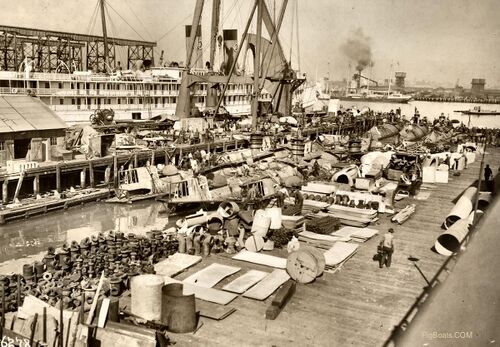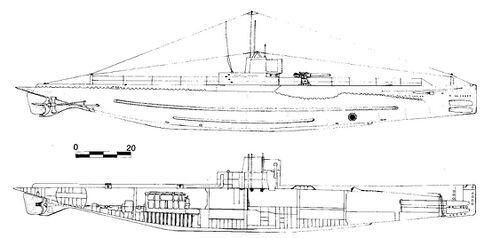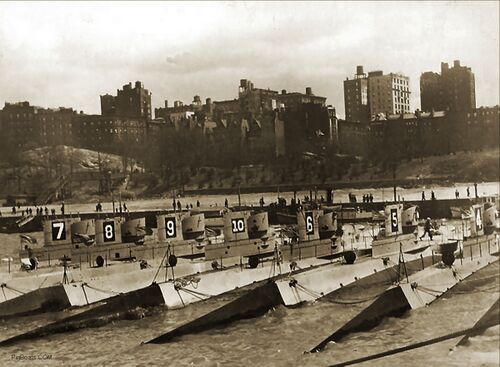R-class: Difference between revisions
Pbcjohnston (talk | contribs) Added R-class group section |
Pbcjohnston (talk | contribs) mNo edit summary |
||
| Line 4: | Line 4: | ||
<div style="text-align: justify;"><span style="color:#00008B">The 27 R-class submarines were built to two distinctly different designs at three shipyards. Both designs had similar operational and military characteristics, but had vastly different internal arrangements, equipment installations, and external appearances. The two designs were developed by the Electric Boat Company (EB) of New York City (later Groton, CT.) and the Lake Torpedo Boat Company of Bridgeport, CT. R-1 through R-14 were of the EB design and were built at Bethlehem Quincy near Boston (formerly Fore River Shipbuilding Company). R-15 through R-20 were of the EB design and built at Bethlehem San Francisco (formerly Union Iron Works). R-21 through R-27 were built by Lake at his Bridgeport yard. | <div style="text-align: justify;"><span style="color:#00008B">The 27 R-class submarines were built to two distinctly different designs at three shipyards. Both designs had similar operational and military characteristics, but had vastly different internal arrangements, equipment installations, and external appearances. The two designs were developed by the Electric Boat Company (EB) of New York City (later Groton, CT.) and the Lake Torpedo Boat Company of Bridgeport, CT. R-1 through R-14 were of the EB design and were built at Bethlehem Quincy near Boston (formerly Fore River Shipbuilding Company). R-15 through R-20 were of the EB design and built at Bethlehem San Francisco (formerly Union Iron Works). R-21 through R-27 were built by Lake at his Bridgeport yard. | ||
Several of these boats served in WWII as stateside training submarines. None made war patrols in the Pacific, although a few made anti U-boat patrols in the Caribbean. [[R-12|USS R-12 (SS-89)]] was lost on June 12, 1943 off Key West due to hull failure. There were just five survivors. The rest of the crew are "on eternal patrol". | Several of these boats served in WWII as stateside training submarines. None made war patrols in the Pacific, although a few made anti U-boat patrols in the Caribbean. [[R-12|'''USS R-12 (SS-89)''']] was lost on June 12, 1943 off Key West due to hull failure. There were just five survivors. The rest of the crew are "on eternal patrol". | ||
The class is broken down by groups below.</span></div> | The class is broken down by groups below.</span></div> | ||
Revision as of 19:39, 11 September 2023

Design and Construction Notes
Several of these boats served in WWII as stateside training submarines. None made war patrols in the Pacific, although a few made anti U-boat patrols in the Caribbean. USS R-12 (SS-89) was lost on June 12, 1943 off Key West due to hull failure. There were just five survivors. The rest of the crew are "on eternal patrol".
The class is broken down by groups below.R-1 through R-14 (EB design built at Bethlehem Quincy)

R-15 through R-20 (EB design built at Bethlehem San Francisco)

BSF launched their boats with much of the superstructure and the conning tower fairwater yet to be installed, and with a false bow that was later replaced with the permanent one prior to completion. This is in marked contrast to the Bethlehem Quincy (BQ) yard near Boston (previously known as Fore River Shipbuilding) that built their group of R-boats with most of the superstructure complete and the conning tower fairwater in place. The cylindrical ribbed tower in the center of each boat is the pressure proof conning tower itself, used as a periscope station for making submerged attacks. Later in the construction phase a sheet steel fairwater would be built around the conning tower to provide a smooth flow of water around the tower, to provide a bridge for the Officer of the Deck and lookouts while surfaced, and to provide supports for the periscopes.
The docks on both sides of the submarines are stacked with huge amounts of materials for ship construction. BSF was also building destroyers and civilian merchant ships at this time and much of this material may be for those ships, as some of it is too large for submarines. What looks like huge sheets of cork insulation are stacked near the center of the photograph. This was applied to the interior of the pressure hull to help control the temperature of the interior of the boat. It was also to prevent condensation from dripping all over the crew and equipment causing discomfort and electrical shorts and grounds. There are also piping unions, elbows, and junctions stacked around seemingly by the hundreds.R-21 through R-27 (Lake design built at Lake Torpedo Boat Company)

General R-class group photos.

Page created by:
Ric Hedman & David Johnston
1999 - 2023 - PigBoats.COM©
Mountlake Terrace, WA, Norfolk, VA
webmaster at pigboats dot com